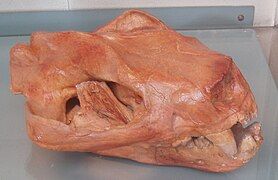Patriofelis
| Patriofelis Temporal range: Early-mid Eocene (Bridgerian)
| |
|---|---|

| |
| Patriofelis ferox skeleton in storage at the American Museum of Natural History | |

| |
| Reconstruction of Patriofelis ferox | |
| Scientific classification | |
| Domain: | Eukaryota |
| Kingdom: | Animalia |
| Phylum: | Chordata |
| Class: | Mammalia |
| Order: | †Oxyaenodonta |
| Family: | †Oxyaenidae |
| Subfamily: | †Oxyaeninae |
| Genus: | †Patriofelis Leidy, 1872 |
| Type species | |
| †Patriofelis ulta Leidy, 1870
| |
| Species | |
| Synonyms[3] | |
|
synonyms of genus:
synonyms of species:
| |
Patriofelis ("father of cats") is an extinct genus of carnivorous placental mammals from the extinct subfamily Oxyaeninae within the extinct family Oxyaenidae. It was a large cat-like predator which lived in North America during the Bridgerian NALMA (part of the early-middle Eocene, 50.3-46.2 Ma). Fossils have been found in Wyoming, Colorado, and Oregon.[8]
Patriofelis could reach around 1.2 to 1.8 metres (3.9 to 5.9 ft) long, not including the tail. The type species Patriofelis ulta is most common in the lower Bridger Formation in the Bridger Basin of southwestern Wyoming. It has also been found in the Huerfano Formation of Colorado. Patriofelis ulta was a smaller species, weighing about 30 kilograms (66 lb).[8]
A second species, Patriofelis ferox, was originally known as Limnofelis. It was much larger than Patriofelis ulta, up to 100 kilograms (220 lb), close to the size of a large jaguar. It is most common in the Bridger Basin as well, both the lower Bridger and lower Washakie formations. Fossils of this species also occur in the Clarno Formation at John Day Fossil Beds National Monument, Oregon.
Patriofelis had a broad short-snouted skull, short legs with broad plantigrade feet, and a relatively long tail. The teeth were very thick relative to other oxyaenids, similar to hyenas in some regards.[9][8]
Paleobiology
[edit]J.L. Wortman (1894, 1902) suggested that Patriofelis may have been a semiaquatic otter-like predator specialized for hunting turtles, while H.F. Osborn (1900) argued that it was an arboreal generalist with cat-like behavior. W.D. Matthew (1909) disagreed with both ideas, as its short limbs and blunt claws would have made it more suited for hunting on the ground.
Two partial skeletons of Patriofelis ulta collected in the 1950s were redescribed by Kort et al. (2022).[8] They found that it had a unique interlocking spinal column which made the backbone very stiff, unlike modern carnivorans and more similar to armadillos and artiodactyls (even-toed ungulates).[8] These interlocking structures (known as revolute zygapophyses) gave its backbone a range of motion similar to that of a sheep. As Patriofelis was an early experiment in large body size among carnivorous mammals, stiffening features would have been an interim strategy in the tradeoffs between torso stabilization and body size.[10]
The neck was muscular and the head was held in a high posture. The limbs, though short, were very robust and flexible. The limb proportions and inflexible spine are completely inconsistent with a semiaquatic or arboreal lifestyle. Instead it was probably a terrestrial ambush predator, adapted to navigate through thick brush and grapple prey with its strong forelimbs.[8]
Gallery
[edit]-
Restoration of Patriofelis ferox by Charles R. Knight, 1896
-
Skull of Patriofelis ulta at Muséum national d'Histoire naturelle, Paris
References
[edit]- ^ O. C. Marsh. (1872.) "Preliminary description of new Tertiary mammals. Part II." American Journal of Science 4(21):202-224
- ^ J. Leidy, (1870.) Untitled [Patriofelis ulta proposed during Proceedings of the March 8 meeting of the Academy of Natural Sciences], in Proceedings Proceedings of the Academy of Natural Sciences of Philadelphia, Volume 22, p. 9-11.
- ^ J. Alroy. (2002.) "Synonymies and reidentifications of North American fossil mammals."
- ^ J. L. Wortman. (1901.) "Studies of Eocene Mammalia in the Marsh Collection, Peabody Museum." The American Journal of Science, series 4 12:193-206
- ^ O. C. Marsh. (1872.) "Note on a new genus of carnivores from the Tertiary of Wyoming." The American Journal of Science and Arts, series 3 4(19-24):406
- ^ W. D. Matthew. (1909.) "The Carnivora and Insectivora of the Bridger Basin, middle Eocene." Memoirs of the American Museum of Natural History 9:289-567
- ^ R. H. Denison. (1937.) "The broad-skulled Pseudocreodi." Annals of the New York Academy of Sciences 37:163-257
- ^ a b c d e f Kort, Anne E.; Ahrens, Heather; David Polly, P.; Morlo, Michael (2021-10-01). "Postcrania and paleobiology of Patriofelis ulta (Mammalia, Oxyaenodonta) of the Bridgerian (lower–middle Eocene) of North America". Journal of Vertebrate Paleontology. 41 (6). doi:10.1080/02724634.2021.2045491. ISSN 0272-4634.
- ^ Neal Robbins (2006.) "Paleontology Discussions, Patriofelis - A Creodont"
- ^ Kort, Anne E.; Jones, Katrina E. (2024). "Function of revolute zygapophyses in the lumbar vertebrae of early placental mammals". The Anatomical Record. 307 (5): 1918–1929. doi:10.1002/ar.25323. ISSN 1932-8486.


